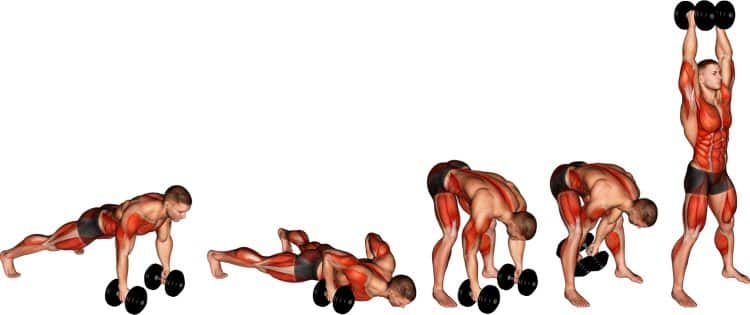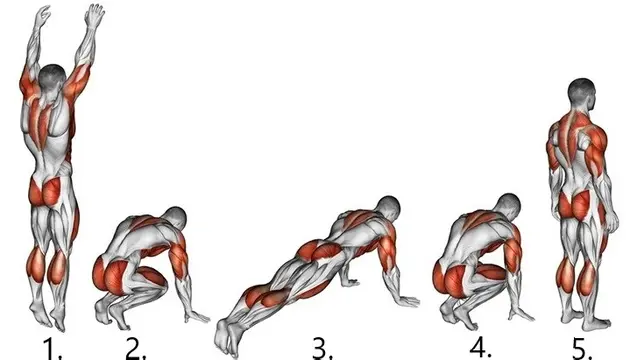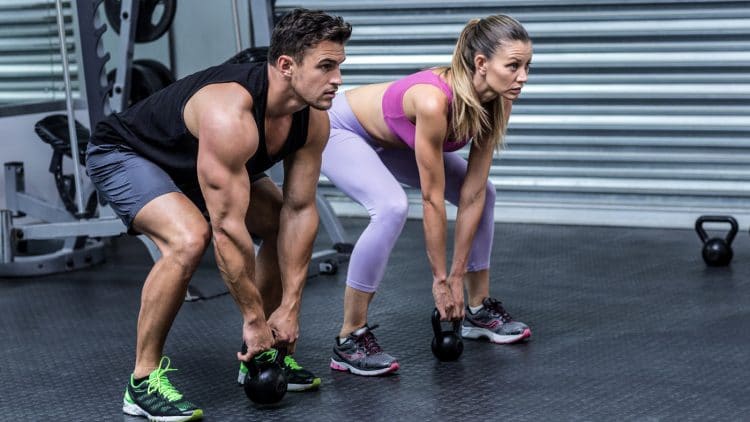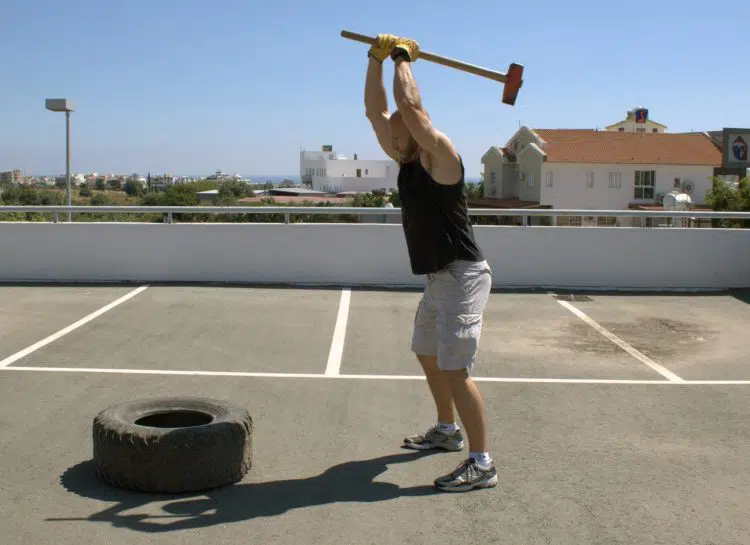It’s hard to believe that CrossFit has been around for over two decades. What was initially labeled a workout fad soon became a fitness phenomenon, and there are now CrossFit gyms, called boxes, all over the world. CrossFit has also become an internationally recognized professional sport.
CrossFit is a form of cross-training and is an interdisciplinary workout program that uses lots of different exercise styles to develop a high level of all-around fitness. It borrows from gymnastics, athletics, Olympic weightlifting, kettlebell lifting, strongman, powerlifting, calisthenics, and even bodybuilding to create an almost infinite number of varied workouts. The workouts are called WODs, which is short for Workout of the Day.
As well as using existing training methods and exercises, CrossFit has also invented (or rediscovered) several unique exercises, including the topic of this article – the devil press.
We reveal why and how to do the devil press and provide you with the best variations and alternatives of this demonic exercise.
Devil Press – Muscles Worked
The devil press, interchangeably called the devil’s press, is a compound exercise that combines several well-known exercises into a sequence. As such, the devil press is technically an exercise complex. The devil press is virtually a full-body exercise as it involves so many movements and muscle groups.

The primary muscles trained by the devil’s press include:
Level Up Your Fitness: Join our 💪 strong community in Fitness Volt Newsletter. Get daily inspiration, expert-backed workouts, nutrition tips, the latest in strength sports, and the support you need to reach your goals. Subscribe for free!
- Quadriceps – there are four muscles in the quadriceps group: the rectus femoris, vastus lateralis, vastus intermedius, and vastus medialis. These muscles work together to extend your knee joint and are located on the front of your thighs.
- Hamstrings – located on the back of your thighs, the hamstrings flex your knees and extend your hips. The three hamstring muscles are the biceps femoris, semimembranosus, and semitendinosus.
- Gluteus maximus – the gluteus maximus is primarily responsible for hip extension. Known as the glutes for short, this is the largest muscle in the human body. Your glutes are basically your butt.
- Core – core is the collective name for the muscles of your midsection, including the rectus abdominis, obliques, transverse abdominis, and erector spinae. These muscles stabilize your spine to prevent unwanted movement. The core is very active during the devil’s press.
- Pectorals major – the pecs are basically your chest muscles. The pecs are responsible for flexion, horizontal flexion, and medial rotation of the shoulder joints. The devil press involves doing a push-up, and push-ups are an excellent chest exercise.
- Deltoids – the deltoids are your shoulder muscles. There are three groups of fibers, called heads, that make up the deltoids: Posterior (rear), medial (middle), and anterior (front), all of which are involved in the devil press.
- Triceps – located on the back of your upper arms, the triceps are responsible for elbow extension. They are very active during the devil’s press exercise.
How to Do the Devil Press
Get more from the devil’s press while keeping your risk of injury to a minimum by following these guidelines:
- Place two equally sized dumbbells on the floor about hip-width apart, so the handles are parallel.
- Stand behind the dumbbells with your feet about shoulder-width apart.
- Reach down and place your hands on the dumbbell handles.
- Jump your feet out and back into the push-up position. Do one push-up, making sure you lower your chest down between your hands. Keep your body straight and don’t arch your lower back.
- Jump your feet back up to the dumbbells.
- In one motion, stand up and swing and press the weights overhead, so your arms are fully extended. This movement is essentially a power snatch.
- Lower the dumbbells back to the floor and repeat.
Throughout the movement, keep your core braced, shoulders packed (down and back), and avoid rounding your lower back. This will make the exercise safer and also improve your performance.
Devil Press Benefits
Not sure whether the devil’s press deserves a place in your workouts? Consider these benefits and then decide!
Low-tech but high-effect
The devil press is a very demanding exercise, but all you need to do it is a pair of dumbbells and a little space. In terms of bang for your buck, the devil press is definitely an effective exercise.
A virtual full-body workout
There are very few muscle groups NOT trained during the devil press. In fact, a set of pull-ups is all you really need to do to ensure you have worked all your major muscles. This is a great movement for time-pressed exercisers who need a quick workout fix.
Burns a lot of calories
The best calorie-burning exercises are those that use a lot of muscle groups. As the devil press is a full-body exercise, you can be assured that doing it will burn lots and lots of calories, which could help you lose fat faster.
An excellent cardiovascular conditioning exercise
While you could do devil’s presses with heavy weights for low reps, it’s probably best when done using light to moderate loads and medium to high reps. That way, it’s not only safer but will place a huge demand on your heart, lungs, and circulatory system.
The devil’s press is an excellent cardiovascular conditioning exercise and ideal for all forms of high-intensity training, including for circuit training, Tabatas, PHA training, and other high-octane workouts.
A CrossFit staple
The devil’s press often features in WODs and has also been part of the annual CrossFit games. Whether you do CrossFit at a box or at home, you’re bound to experience the devil’s press from time to time. While this isn’t an advantage per se, it’s a good reason for including the devil press in your workouts.
Devil Press Drawbacks
While Devil presses are a mostly beneficial exercise, there are also a few drawbacks to consider:
A complex movement
The devil’s press involves a lot of different movements, all done in sequence and quite quickly. As such, exercisers will need good coordination to do it properly. Poor form could lead to serious injury. That’s especially true if you try to do the movement too fast, as is often the case during CrossFit WODs.
Risk of lower back injury
There is a tendency for some exercisers to round their lower back when performing the devil press, especially when they are in the deep squat position.
A rounded lower back is a weak lower back and lifting with a flexed spine often leads to injury. As such, doing the devil’s press requires good hip mobility and a strong core, which many beginners have yet to develop. Spinal injuries can take a long time to heal.
7 Devil Press Variations and Alternatives
Devil presses are a highly effective full-body exercise, but that doesn’t mean you need to do it all the time. There are several variations and alternatives you can use to keep your workouts productive and interesting:
1. Burpees
The devil press shares several similarities with burpees. However, because they involve no weights, burpees are somewhat less demanding. They may be a better choice for some beginners and less fit people. Also, you can do burpees anywhere and anytime as they require no equipment.
Level Up Your Fitness: Join our 💪 strong community in Fitness Volt Newsletter. Get daily inspiration, expert-backed workouts, nutrition tips, the latest in strength sports, and the support you need to reach your goals. Subscribe for free!

How to do it:
- Stand with your feet together and your arms by your sides. Brace your core and pull your shoulders down and back.
- Bend your knees and squat down. Place your hands flat on the floor just in front of your feet.
- Jump your feet out and back into the push-up position.
- Do one complete push-up.
- Jump your feet back up to your hands and then leap into the air.
- Land on slightly bent knees and repeat for the desired duration or number of reps.
You can make burpees easier by omitting the push-up and/or the leap into the air.
2. Thrusters
Thrusters are another CrossFit full-body strength and conditioning exercise. In this case, you’ll be combining a front squat with an overhead press. You can do thrusters with a barbell, dumbbells, or a medicine ball.
How to do it:
- Stand with your feet about shoulder-width apart, toes turned slightly outward. Hold your chosen weight in front of your upper chest. Brace your core and pull your shoulders down and back. Look straight ahead.
- Bend your knees and squat down until your thighs are parallel to the floor or a little lower.
- Quickly stand up and use this momentum to help you push the weight overhead to arms’ length.
- Lower the weight back to your shoulders and repeat.
3. Sumo deadlift high pull
The sumo deadlift high pull is yet another CrossFit combo exercise. However, where thrusters are a pushing exercise, this one is a pulling exercise that works your posterior chain and biceps. As such, it’s the perfect partner to thrusters as, between them, they train all anterior and posterior muscle groups.
How to do it:
- Place a barbell on the floor and stand with your toes beneath it, feet about 1.5 shoulder-widths apart, and toes turned slightly outward.
- Bend your knees, push your hips back, and bend over. Grasp the barbell with a shoulder-width overhead grip. Brace your abs, pull your shoulders down and back, and look forward.
- Drive your feet into the floor and stand up quickly. Use this momentum to help you pull the bar up the front of your body to around mid-chest height.
- Lower the bar back to the floor and repeat.
- Alternatively, you can start and finish sumo deadlift high pulls with the bar just below knee height, which is called the hang position.
4. Eight-count bodybuilder
This exercise is a twist on the burpee. However, it’s lower impact and done in a tempo-controlled manner, hence the name. The eight-count bodybuilder is popular in the military, where it’s often used during squad PT sessions.
How to do it:
- Stand with your feet together and your arms by your sides.
- Squat down and place your hands on the floor. (count one)
- Jump your feet out and back into the push-up position. (count two)
- Do one complete push-up. (count three and four)
- Jump your feet out into a wide straddle position. (count five)
- Jump your feet back together. (count six)
- Bring your feet back into your hands. (count seven)
- Stand up straight. (count eight)
5. Kettlebell swings

Like the devil press, kettlebell swings are a potent metabolic conditioning (met-con) exercise that will torch fat while engaging almost every muscle in your body. Just a few reps will make it clear that this exercise is effective as your heart and breathing rate go through the roof.
Kettlebell swings are an excellent exercise for EMOM and HIIT workouts, both of which are great for improving your conditioning and body composition.
Learn how to do kettlebell swings here.
6. Dumbbell squat, curl, and press
This combo exercise works almost all the muscles in your body to burn lots of calories and develop muscle mass. Easier to learn and master than the devil’s press, all you need for this exercise is a pair of dumbbells or just a couple of water bottles or cans of food.
How to do it:
- Stand with your feet shoulder-width apart, a dumbbell in each hand, and your arms by your side. Brace your core.
- Squat down until your thighs are roughly parallel to the floor, and then stand up.
- Next, bend your arms and curl the weights up to your shoulders.
- Finally, press the dumbbells up and overhead to arms’ length.
- Lower the weights to your shoulders and then your sides and repeat.
7. Sledgehammer swings
While there is no denying that hammer swings are very unusual and completely different from the devil’s press, in terms of muscles worked and calories burned, it’s a very comparable exercise. It’s also a whole lot of fun!
So, if you have some outdoor space, a sledgehammer, and an old SUV tire, you have everything you need for a stress-busting full-body strength and conditioning workout.

How to do it:
- Place your old SUV tire on its side on the ground. This is your striking target. Hold your hammer with one hand near the end of the handle and one hand further up. Adopt a square or split stance as preferred. Brace your abs.
- Putting your whole body into the swing, hit the upturned wall of the tire as hard as possible.
- The hammer will bounce back a little, so be prepared and use the rebound to help you raise the hammer for another strike.
- Try to alternate sides, either rep by rep or set by set.
There are lots of ways to do sledgehammer training, including:
- 30/30 intervals – work for 30 seconds, rest for 30 seconds, and repeat 10-20 times
- 3-minute rounds – work for three minutes, rest for one minute and repeat 3-5 times
- 20-1 rep descending pyramid – do 20, 19, 18, 17, etc. reps as fast as possible
- 100 hits as fast as you can
- 500 hits as fast as you can
- Tabata intervals – work for 20 seconds, rest for 10 seconds, and repeat eight times
Devil Press – Wrapping Up
The devil’s press is a very challenging full-body dumbbell and bodyweight exercise. It’s fast becoming a CrossFit favorite and has already featured in several CrossFit Games. All you need to do it is some dumbbells and a little space. In return, this exercise will kick your BUTT!
However, blending several already demanding exercises into a complex means that this exercise may be too technically advanced for some beginners, even with light dumbbells. There is a risk of injury if the devil press is not performed with good technique.
But, if you are looking for a low-tech but high-effect exercise that’ll take your conditioning to the next level, the devil’s press could be the exercise you’ve been waiting for. So, try it today, and don’t forget to let us know how you get on!
Interested in measuring your progress? Check out our strength standards for Push Ups, Pull Ups, Snatch, and more.








